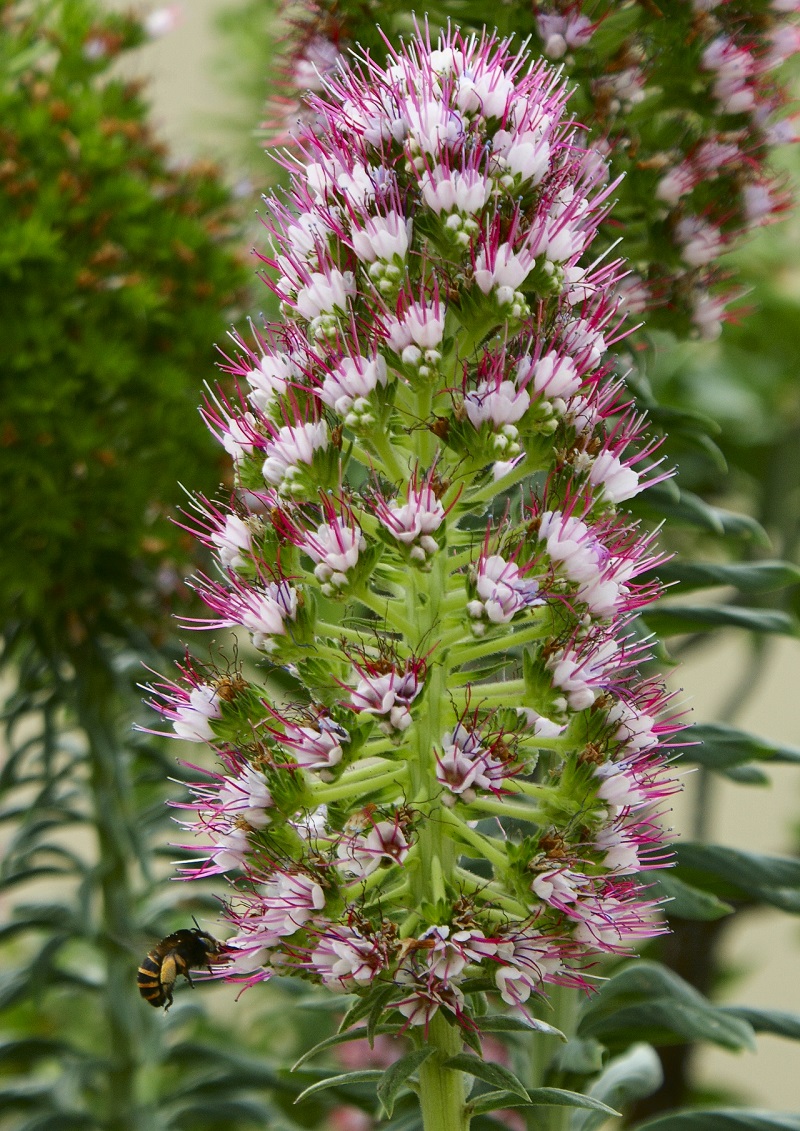The Pico Branco management and conservation measures, implemented or underway, contemplate actions leading to the environmental protection of this ZEC. The conservation of nature, environmental protection and the promotion of the participation of the population and visitors in the enjoyment, dissemination and preservation of the space are the main strategic pillars. These actions have fostered knowledge about biodiversity and the recovery of natural ecosystems, with an improvement in the state of conservation of its plant cover, with emphasis on the increase of the distribution area of the Porto Santo endemism, Echium portosanctense, a shrub which 20 years ago was extremely rare. The ongoing management measures provide a trend towards improving the conservation status of their habitats and ecosystems.
Echium portosanctense
Furthermore, together with the afforestation work on the island of Porto Santo, the measures taken by the Regional Government in the 1990s to control the herds of wild livestock, under the policy of sheep and goat reduction on land appropriate for forestry, have enabled intervention in some habitats, given the significant improvements in soil and climate which have been promoting the development of natural vegetation, which also sprouts spontaneously in very characteristic niches. Particularly important are the areas such as Pico Branco and Terra Chã, which are priority sites which include the presence of endemic species, some of which are present only in these sites. There has been definite recovery of the natural vegetation cover in the area surrounding this ZEC, extending along the side which integrates the Pico Branco path, in a restoration situation which lives up to the seminal potential in these places and to the soil and microclimatic values, in a synergy of ecological interactions which reward these spaces with glimpses of success.
Relative to the Islets of Porto Santo, which are part of the RAMPPS (Network of Protected Marine Areas of Porto Santo) and are also a ZEC, the vegetation of the Islets of Cenouras, Fora and Fonte da Areia is in good state of conservation and the marine habitats belonging to Annex I of the Habitats Directive are classified as having a "Very Good Conservation Status". The control and monitoring of this protected area suggests that there is a tendency to maintain the conservation status of its habitats and ecosystems.
As for the remaining habitats and ecosystems in the candidate Biosphere Reserve, there is insufficient information to define in detail their status and trends. In the framework of their management, improving the degree of knowledge and adjusting protection and conservation mechanisms to the trends identified and the designs outlined for the Porto Santo Biosphere Reserve is recommended.
Considering the low average annual rainfall which characterises Porto Santo and which conditions the activities of both reforestation and agriculture, it is pertinent to promote a greater use of rainwater through the increase of water storage structures in agroforestry areas, coordinated with the work of torrential correction of the most eroded water lines. Promoting soil protection and control of the hydrological regime and enhancing the landscapes of Porto Santo, making them richer and more diversified, together with the conservation and recovery of species and habitats and the establishment of ecological corridors, essentially along the water lines, are goals present in the management objectives of the Biosphere Reserve of Porto Santo.
In general terms, space management should be oriented towards increasing the natural values at the origin of the classification of protected habitats, as well as favouring their genetic wealth and endemism. Thus, forest conservation and management objectives - manifested in forest planning and management instruments or in conservation and management programmes and measures for protected areas - are in keeping with the fostering and maintenance of habitats of clear ecological value, both for fauna and flora. This occurs specifically through the conservation of genetic diversity, especially in the core areas of the Reserve, and, due to the presence of invasive species, with control of invasion patches, in order to condition their dispersion. These control actions take on greater importance in areas dedicated to the conservation of flora and fauna diversity, or where rare species have already been registered, favouring or fostering their expansion.



